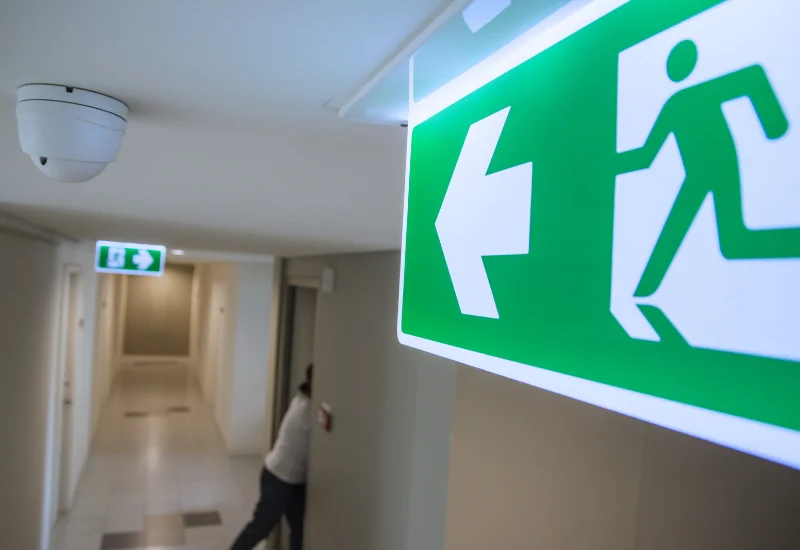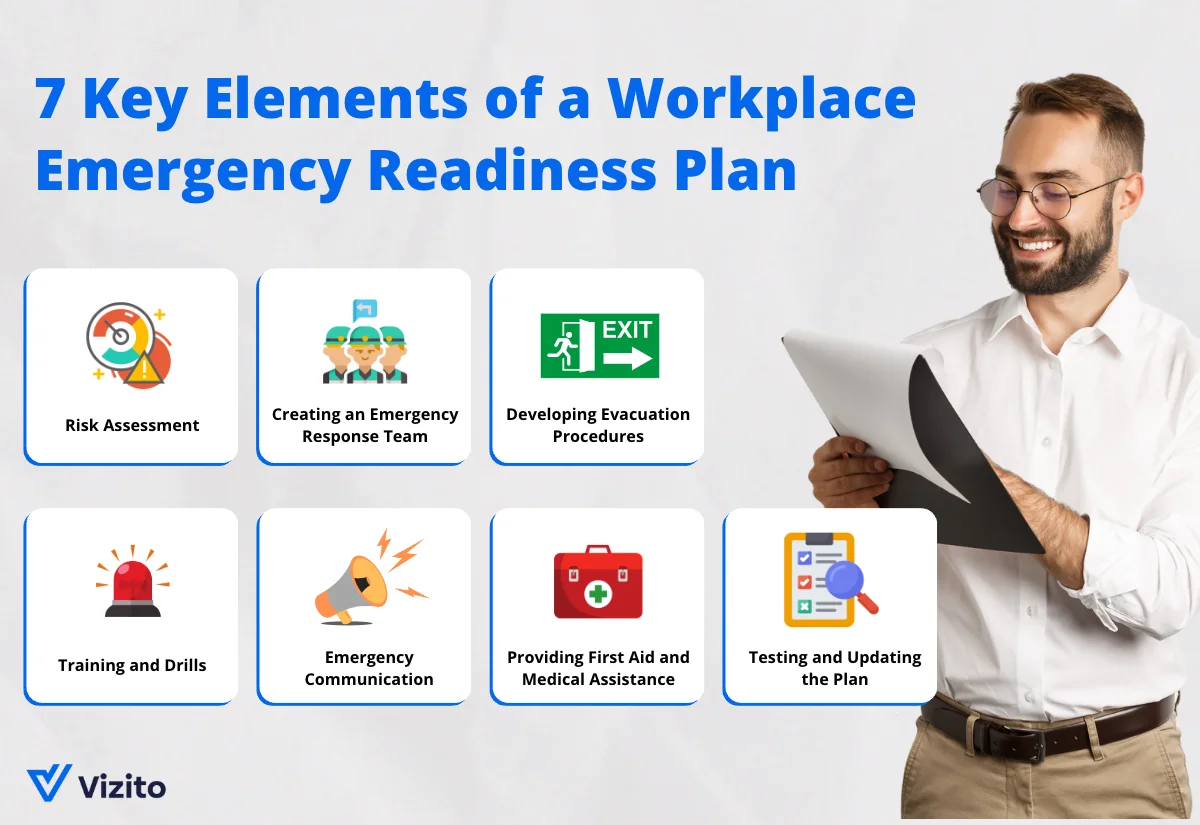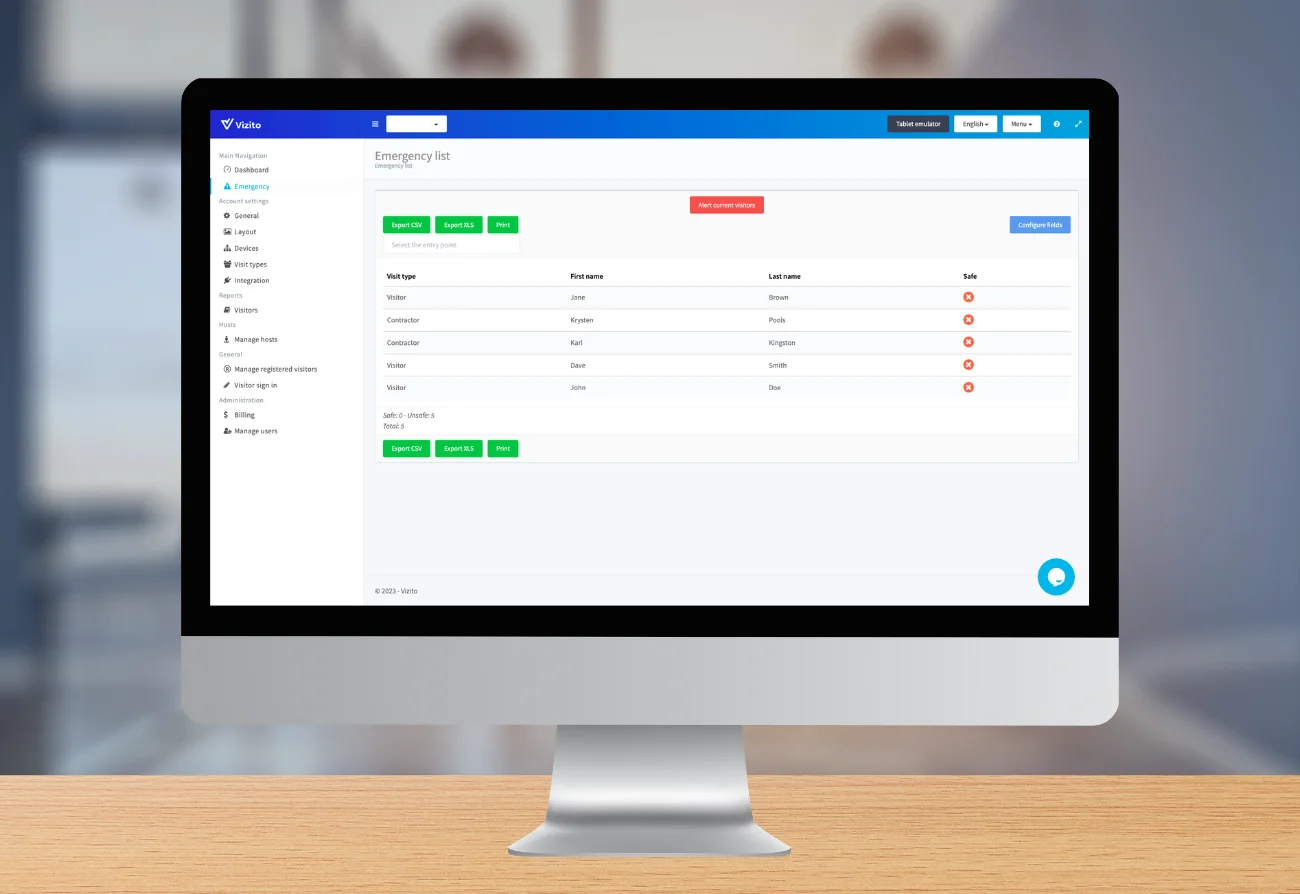
Jun 03, 2025
Learn 7 key elements or 7 steps that will help you get started with drafting your own workplace emergency preparedness plan. You can also use this guide to improve your existing plan and keep it up to date with essential elements.
Written by Mary - Written: July 10, 2023

Emergency readiness is not just a buzzword. It’s a mission-critical strategy that every business needs to take seriously. The goal is to create a secure environment that ensures employees’ safety and reduces damage in the event of an emergency. In this article, we’ll guide you through building a robust emergency plan that prepares your workplace for unforeseen incidents.
Before creating an emergency plan, it’s vital to understand the importance of emergency readiness. Emergency preparedness isn’t about reacting to a crisis, but about having systems in place to ensure the safety of your employees and operations. It includes creating evacuation procedures, training employees, implementing safety measures, and ensuring effective communication during an emergency (source).
In every workplace, ensuring the safety and well-being of the employees is of utmost importance. Emergencies can happen at any moment, and being prepared is essential for the smooth functioning of any organization. Whether it’s a fire, a natural disaster, or even something as ordinary as a power outage, having an emergency readiness plan can make all the difference. Wading through a crisis without a well-thought-out plan in place is like going into battle without armor - it can be disastrous.
By thinking ahead, you can protect your employees as well as your business. You can ensure a swift response, minimizing both panic and potential damage. Additionally, you create a sense of security and trust among your employees that eventually leads to increased morale and productivity. It also enhances your brand image, instilling confidence in the eyes of potential clients and customers.
With a well-established emergency readiness plan, you can work with a calm mind, knowing that your workplace is safe.

Creating a robust emergency readiness plan involves several elements and steps. Delve deeper into these essential elements:
Understanding potential risks in your workplace is the first step in creating an effective emergency plan. Every workplace is unique, with specific risks and vulnerabilities. Conducting a comprehensive risk assessment helps identify potential hazards and threats, enabling you to tailor your emergency readiness plan to your business’s unique needs.
Assessments should consider all possible emergencies that could occur in your specific location and industry. This could range from natural disasters like earthquakes, floods, and storms, to human-caused incidents like fires, explosions, chemical spills, or even violence in the workplace.
Understanding your workplace’s unique risks allows you to develop appropriate procedures for each type of emergency, increasing the efficacy of your emergency response.
A dedicated Emergency Response Team (ERT) is critical in managing and mitigating the impact of an emergency. This team is responsible for developing, implementing, and maintaining the emergency readiness plan.
The team should include individuals from various departments and should be trained to handle various emergency situations. They will be responsible for guiding employees to safety during emergencies, liaising with emergency services, and overseeing the recovery process post-emergency.
A well-planned evacuation procedure is paramount in ensuring the safety of your employees during an emergency. This includes establishing clear evacuation routes, ensuring these routes are unobstructed, marking emergency exits clearly, and designating safe assembly points outside the building.
Regular audits of the workplace environment can help identify potential bottlenecks or obstructions that could hinder a swift evacuation. In addition to this, integrating a digital visitor management system like Vizito can enhance your evacuation procedures by providing real-time data about who is in your building at any given time, aiding in swift and accurate headcount during an evacuation.
An emergency readiness plan is only as good as the people implementing it. Regular training ensures all employees understand the plan, their roles during an emergency, and how to respond in various situations. Training should be comprehensive and cover all aspects of the emergency plan, from initial alerts to evacuation procedures and post-emergency procedures.
In addition to training, regular drills are vital. Drills simulate emergency situations, providing employees the opportunity to practice their response, identify any issues or areas of confusion, and become familiar with evacuation routes and procedures.
Effective communication is crucial during an emergency. Establishing a reliable emergency communication system ensures employees are quickly alerted about emergencies and provided with necessary updates and instructions during the situation.
The communication system could include alarm systems, text alerts, public announcement systems, or any other method that quickly and efficiently reaches all employees. It’s important to ensure the communication system is reliable, easily accessible, and can reach all employees, including remote workers.
Our blog post on how visitor management systems can improve safety in your company provides additional insights into the role of digital tools in emergency readiness.
We’ve covered quite a lot of ground when it comes to workplace emergency readiness, but we’re not done just yet. We can’t forget about the crucial aspect of providing first aid and medical assistance. When an emergency strikes, it’s important to have trained individuals who can administer immediate care to those in need.
Having employees with basic first-aid knowledge can be a lifesaver. They can assess the situation, stabilize injured individuals, and provide initial treatment until professional medical help arrives. This could include CPR, applying pressure to stop bleeding, or even simply comforting someone who is in distress.
Additionally, it’s essential to have a fully stocked first aid kit readily available in easy-to-find locations throughout the workplace. This kit should be regularly checked and restocked to ensure all necessary supplies are up-to-date. It might also be a good idea to consider having automated external defibrillators (AEDs) on-site, especially if your workplace is prone to certain medical emergencies.
An emergency readiness plan needs to be continuously tested and updated. Testing your emergency readiness plan is crucial because it allows you to identify any weaknesses or gaps in your plan. you want to know if your emergency procedures will actually work when you need them the most.
So how do you go about testing and updating your plan? Firstly, gather feedback from your employees who participated in the testing process. They are the front-line soldiers in the war against workplace emergencies, so their insights are invaluable. Secondly, analyze the test results and identify areas for improvement. These could be anything from revising evacuation routes to enhancing communication protocols. Lastly, make sure you regularly review and update your plan.
Review it annually, or even more frequently if there are significant changes within your organization. Don’t be caught off-guard when an emergency strikes. Stay prepared, keep testing, and keep updating.

A digital visitor management system can significantly improve your emergency readiness plan. In an emergency, knowing who is in your building and where they are is crucial. A digital visitor management system like Vizito helps keep track of visitors, employees, contractors, and anyone else in the building in real time. This is particularly beneficial in an emergency as it aids in a swift and safe evacuation.
Vizito features an Emergency page, containing a list of all current visitors. From this page, you can alert all visitors in the building with a push of a button. You can also export or print the list to share with authorities.
Furthermore, a visitor management system can improve overall workplace security. Read our blog on workplace security, a guide to protecting your business and people.
Emergency readiness in the workplace is not just about having an evacuation plan. It’s about creating a culture of safety where everyone knows their roles during emergencies. This involves a systematic approach that includes risk assessment, creating an emergency response team, developing evacuation procedures, conducting regular training and drills, and establishing an effective emergency communication system.
Integrating modern technologies like a digital visitor management system can significantly enhance your workplace’s emergency readiness. Vizito, for instance, can provide real-time tracking of individuals in the building, aiding in effective evacuation during emergencies, and improving overall workplace safety.
In addition, as we move towards a hybrid working model, ensuring safety across multiple working environments and scenarios becomes paramount. Hence, emergency readiness plans need to evolve to accommodate this new work style.
It’s crucial to remember that while we cannot predict when emergencies will occur, we can certainly prepare for them. As the saying goes, “Failing to plan is planning to fail.” Make emergency readiness a top priority, and ensure your business can respond swiftly and effectively when the unexpected occurs.
For more resources on workplace safety and readiness, consider visiting these external sources:
By planning for emergencies, you’re not just protecting your company’s operations, but more importantly, you’re safeguarding the people that make your business possible. Stay ready, stay safe!
If you want to learn more about how Vizito can help you enhance your workplace safety, start a free trial today.